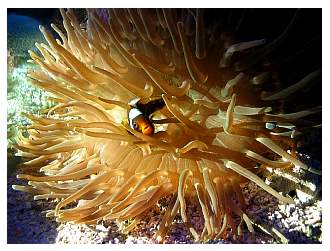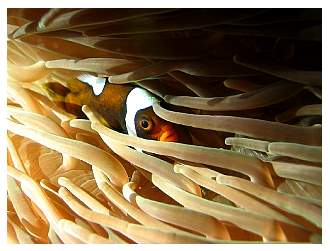|
Gary Majchrzak's Reef Aquarium
Click here
for a higher resolution picture.
|
Introduction & Background:
Hi. My name is Gary,
and I have an addiction.
All kidding aside, it's a privilege and honor to be chosen
as Tank of the Month at Reef Central. I've always been interested
in the biodiversity of life on planet Earth. When I first
discovered that reef aquaria existed, it didn't take me long
to scramble to find out as much about them as I possibly could.
After a year or two of reading whatever I could get my hands
on, I started my first reef aquarium in 1993. This research
paid dividends: my very first reef aquarium was a success.
I soon started phytoplankton and rotifer cultures to feed
the larval clownfish I was raising. I set up several small
coldwater reef systems and a second reef aquarium. I also
started "fragging" small-polyped stony corals and
trading them in for credit at the local fish stores in my
area. When we moved into our present home, back in '97, I
set up one (larger) reef system to house everything I had
accumulated up to that point.
I should mention something rather important here: in the
very beginning I purchased the best live rock that I could
afford - and from different sources, too. I mention this because
the liverock that I chose to purchase in 1993 had a huge impact
on my reefkeeping experience to this very day. You see, this
small, strange looking polyp hitchhiker was on one of the
live rock pieces that came from Indonesia…
My Current Reef Aquarium:
My present display aquarium is a 72"
x 24" x 30" 225-gallon "high" tank manufactured
by Perfecto. Perfecto drilled it for two returns and one drain
where I specified the holes to be located - down the middle
of the aquarium's bottom, so the returns and drain are internal
(inside the display). I did this because the aquarium is set
up as an "island" display, meaning it can be viewed
from all four sides. We actually tore down a wall in the house
and replaced it with a reef aquarium. The main drain and water
returns are plumbed down through the bottom of the aquarium
and its stand to our basement. The internal standpipes were
surrounded with cinder blocks to protect them from shifting
rock. I then used "Thorite"
marine cement to bond the live rock together over the cinderblocks
to hide the standpipes. The only regret I had with my original
design was not having two drains, so I added a second drain
in 2004.
System and Filtration:
Water
Parameters:
|
|
Specific
Gravity: 1.025 |
|
|
Temperature:
75-83° F |
|
|
Calcium:
>400 ppm |
|
|
Alkalinity:
>10 dKH |
|
|
pH:
~
8.2 |
|
|
|
I have a 75-gallon aquarium that's
been drilled for sump duty. The main circulation pump is an
Iwaki 100RLT with two return lines to the display aquarium.
Additional circulation in the main display is achieved with
powerheads connected to a wavemaking device. Mechanical filtration
is provided by running the drain line through a 100 micron
filter pad located in the sump. A 30" Beckett skimmer
powered by a GenX PCX 40 pump provides additional filtration,
and a My Reef Creations calcium reactor helps to keep calcium
the optimum level. The sump also houses both the heaters and
the thermometer. Carbon is run continuously in the sump.
Routine Maintenance:
Cleaning four sides of an aquarium
is much more of a chore than cleaning just one side, and I
typically do this whenever I can - at least once every other
day. I use quick sweeping motions with the cleaning magnet
to help stir up any detritus that might have settled near
the corners of the glass. This also helps prevent coralline
from getting a foothold on the glass. Water changes (roughly
21%) are performed weekly. Water parameters are checked monthly.
Makeup water for evaporation top-off is kalkwasser (limewater).
The system and its inhabitants are inspected daily.
Feedings:
I've always thought that feeding is
an important and often overlooked subject. I've always heard,
"You are what you eat," and I believe this is also
true for our reef animals. I feed a variety of good foods
daily. Some of the "meaty" foods listed here are
specifically for anemones: nori, VibraGro (Saltwater Staple)
pellets, frozen HUFA enriched mysid shrimp, frozen HUFA enriched
Artemia, scallops, silversides, smelt, Cyclop-eeze,
frozen broccoli florets, frozen orange sections, ProGreen
(by Pro Salt) and Ocean Nutrition flakes. A small "snowstorm"
of food is fed daily. Anemones and certain large-polyped stony
corals are target fed larger foods at least once a week.
Lighting:
|
I'm currently using a 72" PFO
powder-coated aluminum light fixture suspended from the ceiling
by a height-adjustable cable kit. It's very nice to be able
to easily raise and lower the light hood. The lighthood contains
one single-ended 400-watt Hamilton 14K metal halide bulb located
in the center of the tank, and it's flanked on either side
by two 250-watt 6500K Iwasaki halides. All metal halides are
powered by Blueline electronic ballasts. Supplemental lighting
consists of two 72" VHO actinic fluorescent lamps. Additionally,
the tank also receives some direct and indirect natural sunlight.
|
Photoperiod:
|
6:30
AM- VHO actinics on
|
|
7:00
AM- 400-watt center halide on
|
|
9:00
AM- both 250-watt halides on
|
|
6:00
PM- both 250-watt halides off
|
|
7:00
PM- 400-watt center halide off
|
|
8:00
PM- VHO actinics off
|
|
|
|
|
|
Inhabitants:
Invertebrates
It might not be apparent at first glance, but my aquarium
is an anemone-dominated reef. As I alluded to earlier, the
very first livestock addition in my first reef aquarium turned
out to be a type of miniature carpet anemone that was attached
to a piece of live rock from Indonesia. This anemone, Stichodactyla
tapetum, is well known to many reefkeepers who frequent
Reef Central, but it's relatively unknown in the reefkeeping
community at large. I've recently introduced a larger morph
(>5" diameter) of S. tapetum to my aquarium.
Each "mini" and "maxi" carpet anemone
is somewhat unique in its color pattern. Several of these
anemones are incredibly colorful (almost as if they were "tie-dyed"),
and I've never seen anything like them anywhere else.
In addition to the "mini carpets" I have several
other types of anemones: an unidentified small anemone species
that is commonly called a "Tulip" anemone, a blue
Haddon's carpet anemone, S. haddoni, and a Long-tentacle
anemone (LTA), Macrodactyla doreensis. Both the LTA
and the blue Haddon's anemone have spawned in my aquarium.
Two Saddleback anemonefish (A. polymnus) share the
two larger anemones. In addition to anemones, I have many
other invertebrates. Several are "reef janitor"
types that hitchhiked into my aquarium and work to keep it
clean - Stomatella spp. snails, Ophiactis (small
brittlestars), unidentified sponges and many types of segmented
worms, as well as numerous chitons and limpets.
 |
 |
Purple mushrooms were my first invertebrate livestock purchase,
in '93, and they are still alive today. I have a table Acropora
that I introduced in '94 and another type of Acropora
that I introduced in '93. Many other additions were made over
the years, with most of them being captive propagated or accidentally
arriving as hitchhikers, but a few were "wild caught."
Acropora, Montipora, Pocillopora, Seriatopora,
Porites, Sarcophyton, Clavularia, Rhodactis,
Echinopora, Echinophyllia, Oxypora, Favia,
Leptoseris, Tubipora, Sinularia, Acanthastrea,
Zoanthus, Protopalythoa, Pseudocorynactis,
Pavona, Euphyllia, Plerogyra, Turbinaria,
Caulastrea, Platygyra, Hydnophora, Heliopora,
Xenia, Sansibia, Plexaura, Plexaurella,
Pseudoplexaura, Pterogorgia, Millepora
and several yet-to-be-identified corals.
Other invertebrates also include one Tridacna maxima
and one T. crocea, along with a sea cucumber, Holothuria
impatiens.
Fish:
Black Saddleback anemonefish (pair) - Amphiprion polymnus
Orchid dottyback (pair) - Pseudochromis fridmani
Convict tang - Acanthurus triostegus
Purple tang - Acanthurus xanthurum
Mimic Lemonpeel "Chocolate" tang - Acanthurus
pyroferus
Banggai cardinalfish - Pterapogon kauderni
Majestic angelfish - Pomacanthus navarchus
Acknowledgements:
Before I say goodbye I'd like to thank
my wife, kids, friends, family, members of Reef Central and
our local reef aquarium club (the "Upstate Reef Society"
of upstate NY) for all of your support, advice, constructive
criticism and patience over the years.
Feel free to comment
or ask questions about my tank in the Tank of the Month thread
on Reef Central.
|
If you'd like
to nominate a tank for Tank of the Month, click here
or use the button to the right.
|
 |
|

